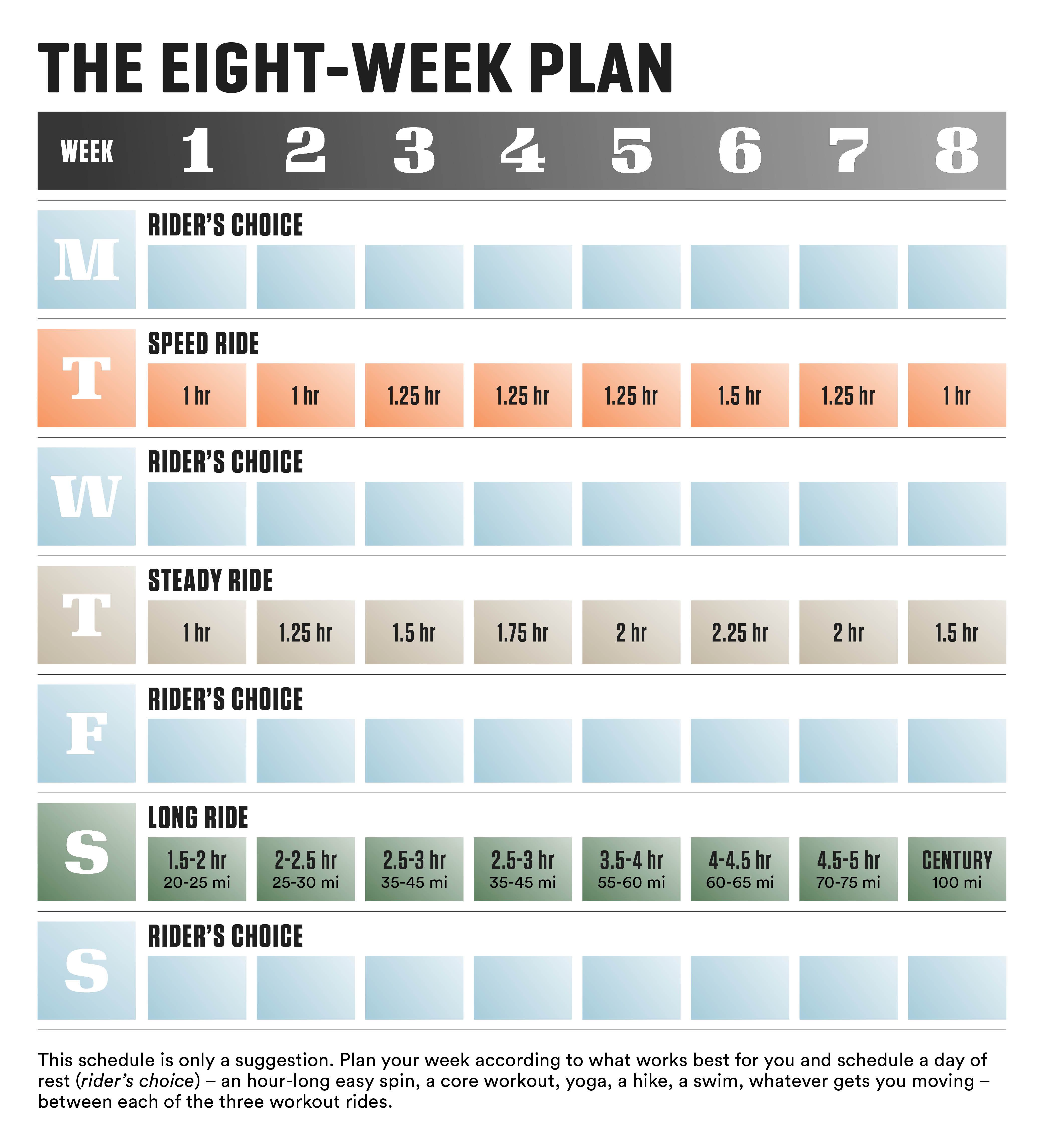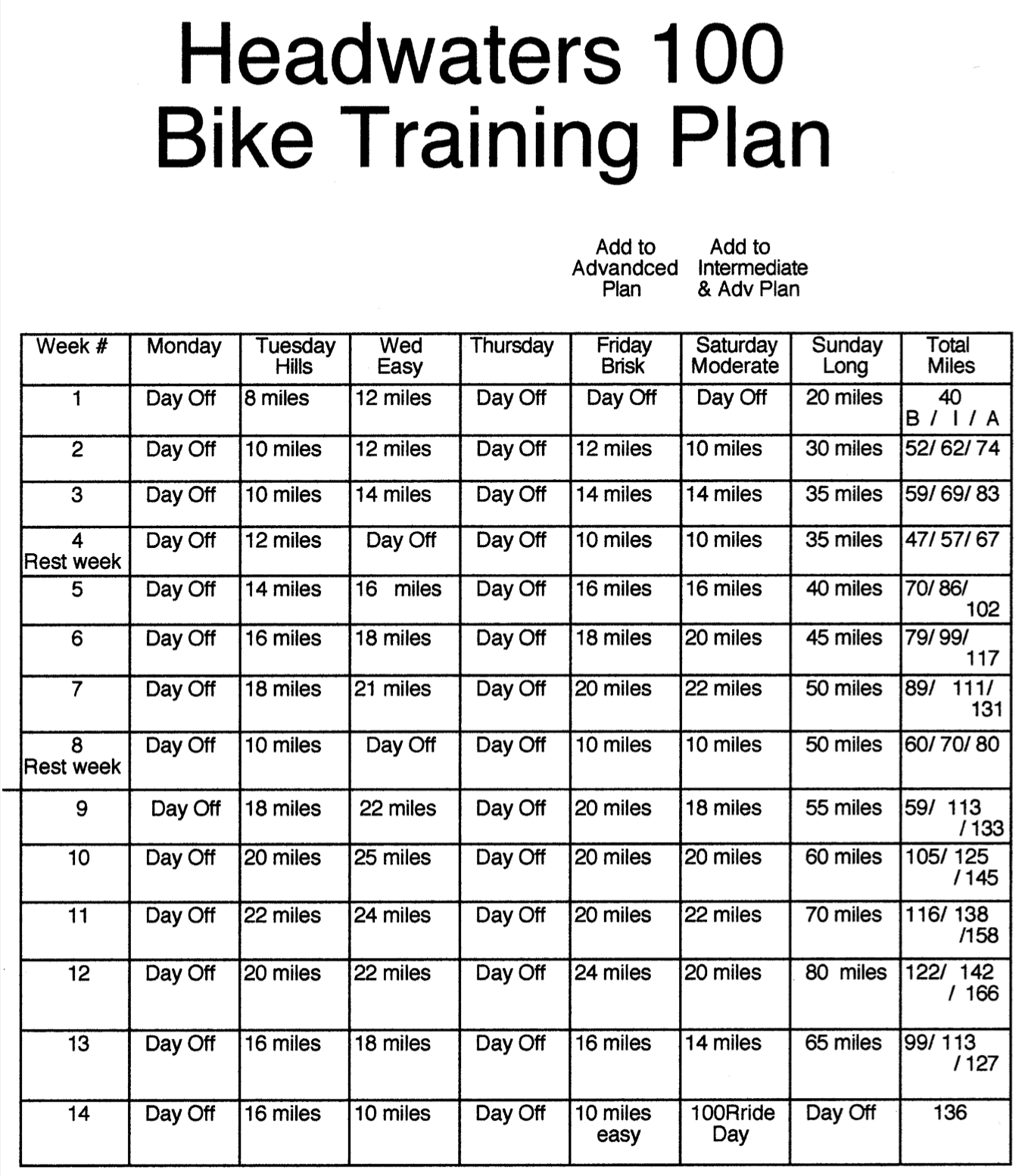A 100 mile bike training plan requires a combination of endurance rides, interval training, and proper rest. Consistency and gradual progression are key to success.
Training for a 100-mile bike ride can be a rewarding challenge. Start by building a solid foundation with regular rides, gradually increasing distance. Incorporate interval training to boost your speed and stamina. Schedule longer rides on weekends to simulate race day conditions.
Rest and recovery are crucial to avoid injury and overtraining. Hydration and nutrition also play vital roles in sustaining energy levels during long rides.
A well-rounded training plan ensures you are prepared physically and mentally for the big day. Stay consistent, listen to your body, and enjoy the journey towards achieving your cycling goal.
Introduction To Century Cycling
Riding 100 miles on a bike is a big challenge. Many cyclists dream of this goal. It is called a century ride. Achieving this can make you feel very proud. It pushes your limits and builds endurance. You get to see beautiful places while riding. Each mile adds to the adventure.
Completing a century has many benefits. It makes you stronger and healthier. Your heart and lungs get a great workout.
Cycling long distances can also improve mental strength. You learn to focus and stay calm. It helps in burning lots of calories. This can aid in weight loss.
Setting Realistic Goals
Understand your current fitness level before starting the 100-mile bike training plan. Track your cycling speed and distance. Take note of how you feel after each ride.
This helps in planning your training effectively. Consult a doctor if you have any health concerns. Start with short rides and gradually increase the distance.
Set a timeline that suits your fitness level. Most people need at least 12 weeks to prepare for a 100-mile ride. Break your goal into smaller milestones.
Aim to increase your distance by 10-15% each week. Rest days are important for recovery. Keep track of your progress to stay motivated.
Essential Gear And Equipment
Quality gear ensures safety and performance during a 100-mile bike training plan. Essential equipment includes a reliable bike, helmet, and hydration system.
Choosing The Right Bike
Picking the right bike is very important. A road bike is best for long rides. Comfort matters the most. Check the bike size to match your height. Good brakes are a must for safety. Gears help in climbing hills. A lightweight bike is easier to ride. Try different bikes before buying.
Must-have Cycling Accessories
- Helmet for safety
- Water bottle to stay hydrated
- Cycling gloves for comfort
- Padded shorts to avoid soreness
- Bike lights for visibility
- Repair kit for emergencies
- GPS device to track your ride

Credit: www.bicycling.com
The Fundamentals Of Training
Building a strong foundation starts with consistent practice. Riding your bike regularly helps your muscles adapt. Begin with shorter rides. Gradually increase your distance.
This builds stamina and confidence. Consistency is key to success. Missing too many days can set you back. Keep a training log. It helps track your progress. Celebrate small milestones. It keeps you motivated.
Cross-training is crucial for overall fitness. It prevents muscle fatigue and injury. Activities like swimming or running are great options. They build different muscle groups.
This boosts your endurance. Yoga and stretching are also beneficial. They improve flexibility. A mix of activities keeps training fun. It prevents boredom and burnout. Cross-training makes you a stronger cyclist.
Creating Your Training Plan
Start with a base mileage that feels comfortable. Gradually increase your mileage each week. Try to add no more than 10% each week. This helps your body adjust without getting hurt.
Plan for longer rides on weekends. Shorter rides can be done during the week. Include one rest day each week. This gives your muscles time to recover.
Balance hard and easy days to avoid burnout. Hard days should be challenging but not exhausting. Easy days should allow your body to recover.
Always listen to your body. If you feel tired, take it easy. Include stretching and light activities on recovery days. This helps keep your muscles loose and flexible.
Nutrition And Hydration Strategies
Eating the right foods can make a huge difference on long rides. Carbohydrates give you energy. Include fruits, whole grains, and pasta in your diet. Protein helps repair muscles. Nuts, eggs, and lean meat are good choices. Fats are also important.
Avocados, nuts, and seeds provide healthy fats. Eat small meals before and during your ride. This keeps your energy up without feeling too full. Carry snacks like energy bars, bananas, and nuts. Always listen to your body. Eat when you feel hungry and don’t wait too long.
Water is key to staying hydrated. Drink water before, during, and after your ride. Aim for one bottle every hour. Electrolyte drinks can help replace lost salts. These drinks are useful on hot days. Carry enough water for your ride.
Plan your route to include water stops. Dehydration can cause cramps and fatigue. Watch for signs like dry mouth, dizziness, and dark urine. Drink even if you don’t feel thirsty. Staying hydrated keeps your body working well.
Mental Preparation Techniques
Building mental strength is very important for long bike rides. Think about your goals and stay positive. Break the ride into small parts. Focus on one part at a time.
This makes the ride seem easier. Visualize yourself finishing the ride. This helps in staying motivated. Practice deep breathing exercises. They can help calm your mind. Stay present and enjoy the ride.
Fear of failure can stop you from riding far. Remind yourself of your training. Trust your hard work. Negative thoughts may come up during the ride. Push them away and think positive. Tiredness can make you want to quit.
Take deep breaths and push through. Your mind is stronger than you think. Remember, every pedal brings you closer to your goal. Stay strong and keep going.
Tracking Progress And Making Adjustments
Track your training data to see how well you are doing. Use a bike computer or a fitness app. Record your miles, time, and speed. Write down how you feel after each ride. This helps you understand your body better. If you feel tired often, you might be training too hard.
Look at your data every week. This helps you find patterns. Adjust your plan if needed. Increase your miles if you feel strong. Reduce your miles if you feel weak. Listen to your body. It’s important to rest when you need it. Rest helps you get stronger.
Check your progress every two weeks. Make small changes to your plan. Add more miles slowly. Do not increase too fast. Balance hard and easy days. This keeps you from getting too tired.
Always include rest days in your plan. Rest days help your muscles recover. Stay flexible and make changes as needed. This keeps your training fun and effective.
Tapering Before The Event
Tapering helps your body recover before the big ride. It reduces training stress. This allows muscles to heal and energy levels to rise. A good taper can improve your performance. It lets you feel fresh and strong on race day.
Plan your taper to start two weeks before the event. Cut down on training volume. Keep the intensity but reduce the time spent. For example, if you bike for 3 hours, cut it to 1.5 hours. Maintain your usual speed.
Rest well. Sleep and nutrition are key. Eat healthy meals and hydrate well. Stay positive and visualize success. This ensures you are mentally ready.
Race Day Strategies
Riding 100 miles is a big challenge. Start at a steady pace. Don’t go too fast at the beginning. Save your energy for later. Keep a consistent speed. This helps you finish strong. Use a bike computer to track your speed. Take short breaks to stretch and hydrate. Listen to your body. Eat small snacks during the ride. This keeps your energy up.
Things can go wrong on race day. Pack a repair kit. Fix a flat tire quickly. Carry extra tubes and a pump. Weather can change fast. Bring a rain jacket.
Stay dry and warm. Know the route. Avoid getting lost. Stay calm if something goes wrong. Focus on solving the problem. Keep a positive attitude. Finish the race strong.
Post-ride Recovery And Reflection
Drink plenty of water after your ride. Stay hydrated to help your muscles recover. Eat a balanced meal with protein and carbs. This helps rebuild muscle tissue and restore energy. Stretch your muscles to prevent stiffness.
Take a light walk to keep blood flowing. Rest is key; aim for at least eight hours of sleep. Use a foam roller to release muscle tension. Avoid heavy exercise the day after a long ride. Let your body fully recover.
Think about what went well during your ride. Identify areas for improvement. Note any discomfort or pain you felt. Adjust your bike settings if needed. Plan your next ride based on what you learned.
Set new goals for distance or speed. Celebrate your achievements to stay motivated. Share your experiences with friends or a cycling group. This can provide valuable feedback and encouragement. Keep a journal to track your progress.

Credit: www.bicycling.com

Credit: www.spoked.ai
Frequently Asked Questions
How Much Training To Cycle 100 Miles?
Training for a 100-mile bike ride typically takes 8-12 weeks. Aim to cycle 3-4 times weekly, gradually increasing distance.
How Do I Prepare For A 100 Mile Bike Ride?
Train consistently, gradually increasing mileage. Eat a balanced diet with carbs, proteins, and fats. Stay hydrated. Ensure your bike fits well. Get adequate rest before the ride.
Is It Possible To Bike 100 Miles A Day?
Yes, it is possible to bike 100 miles a day. With proper training, nutrition, and breaks, many cyclists achieve this goal.
How Many Miles A Week Should I Train For The Century Ride?
Train 80-150 miles per week for a century ride. Gradually increase distance and include rest days.
What Is A 100 Mile Bike Ride Called?
A 100 mile bike ride is often called a “century ride. “
Conclusion
Completing a 100-mile bike ride is a significant achievement. Following this training plan will help you prepare effectively. Consistent effort and dedication will ensure you reach your goals.
Stay motivated, track your progress, and enjoy the journey. With the right mindset, you will conquer those 100 miles confidently.
Happy cycling!

Steven is a professional cyclist and his passion is cycling. He has been cycling for the last 6 years and he loves using bikes while outing as well. Based on his experiences with the different types of bikes; he is sharing his opinions about various bikes so that a beginner can start right away. Find him on Twitter @thecyclistguy Happy Biking.


Leave a Reply